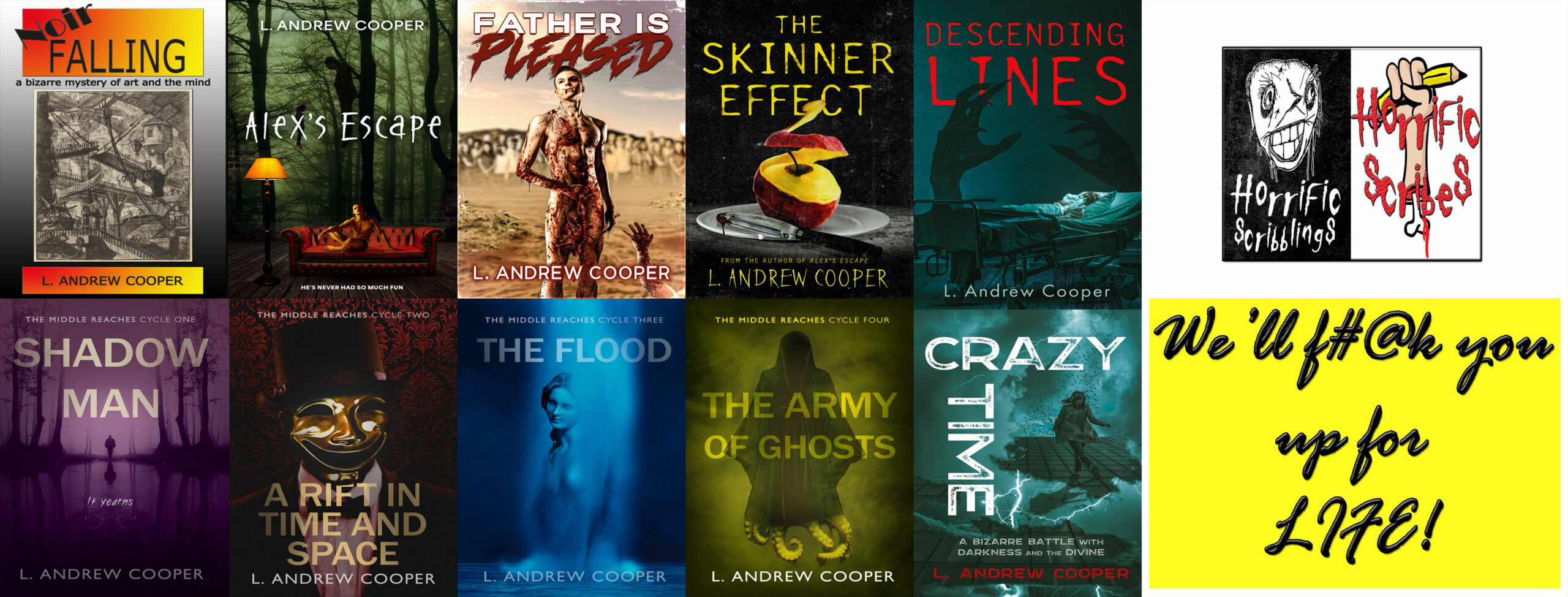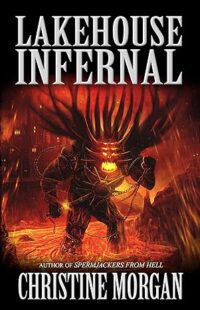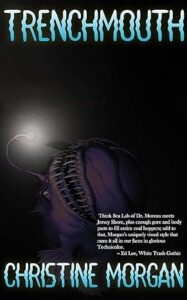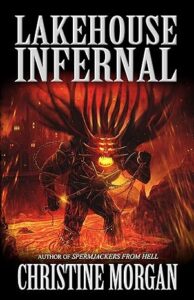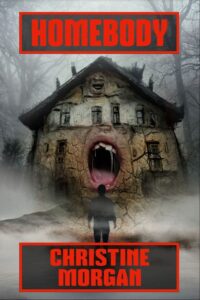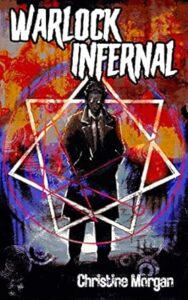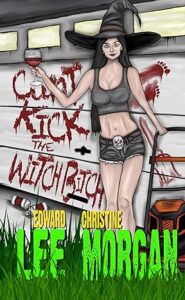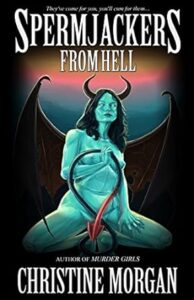Award-winning, extreme, and diabolically clever horror author Christine Morgan is here to discuss some books you can get your filthy hands on now and a few more coming monstrously soon.
Trench Mouth
Fathom Five … a state-of-the-art oceanic research facility, suspended far below the surface. There, in the dark and the deep, a team of top-notch scientists studies the ecosystems and denizens of an aquatic environment as alien as another planet.
There, they also conduct illicit experiments upon hapless human subjects, with the goal of giving our species a chance to adapt to a changing world. Or, at the very least, to create mutant freaky fish-people, because, why not?
Oh, the arrogance and hubris of genius! Oh, the freaky things that already dwell in the strange, hostile depths! In the cold, crushing, silent pressure of a blackness lit only by eerie bioluminescence. Things that don’t take kindly to intruders. Things that are ancient, and enormous, and hungry.
Things like … TRENCH MOUTH.
“Think Sea Lab of Dr. Moreau meets Jersey Shore, plus enough gore and body parts to fill entire coal hoppers; add to that, Morgan’s uniquely visual style that rams it all in our faces in glorious Technicolor.”
—Edward Lee, author of White Trash Gothic
“This is exactly the kind of book I love. Supersonic pacing. Blood spilled on every page. A grisly weird-science techno-thriller set in the crushing stygian darkness, Morgan’s Trench Mouth lures you in and leaves you gasping.”
—Lee Murray, three-time Bram Stoker nominee and author of Into the Mist
Entries in the Infernal Series
Lakehouse Infernal
“Lakehouse Infernal is the coolest, ball-bustingest, most outrageous, and most ENTERTAINING horror novel you’re likely to find in a long time.” – Edward Lee, author of City Infernal
Lake Misquamicus was an unremarkable lake in Florida, unremarkable that is until suddenly it was filled with six billion gallons of blood, bile, pus, piss, shit and …things… directly from the pits of Hell. First the public was in shock, then the government built a wall, and as time passed it became another urban legend. But for some, it has become a travel destination. Spring-breakers, drug-runners, and religious nuts. But a weekend getaway on the shores of Hell may not be the safest idea…
With an introduction by and officially endorsed by splatterpunk legend Edward Lee, Lakehouse Infernal is an official entree in Lee’s infamous Infernal series. Christine Morgan (Spermjackers from Hell) expands on this universe with her own twist on hardcore horror tourism.
“Think Spring Break, only instead of a beach house, it’s a lakehouse, but the lakehouse IS IN FUCKIN’ HELL, that’s right, a chunk of Hell that’s been upheaved and pushed up into our pretty little world—sunny Florida, no less!” – Edward Lee
Warlock Infernal
6 6 6
Six minutes into the unholy consummation, someone finally thought to cut the live feed … but the momentous events were only just getting underway! As the Hell-Centurion Favius claims his kingdom and queen, as the Wall rises and the Dome descends, the survivors trapped inside will face some critical decisions.
Six hours ago, Gregory Nachtwald was holding hands with an angel … and how can anybody go back to any sort of normal life after that? Especially as a newly-awakened warlock with a dark and mysterious family legacy, possessing powers he hardly understands?
Six days later, they went for the nuclear option… a disgruntled and betrayed nation, and a terrified world, preparing to unleash their ultimate weapon against the diabolical stronghold that had once been a remote Florida lake.
Welcome back to Lake Misquamicus for another smutty, gory, depravity-laden adventure in Warlock Infernal, sequel to the Splatterpunk Award winning Lakehouse Infernal!
The Night Silver River Run Red
Some things, according to Cody McCall, are worth risking a whipping. Such as sneaking out with your friends after dark for a peek at the traveling show setting up just outside of town. Oddities, the signs promise. Marvels. Grotesqueries. Exotic attractions and mysterious magics. Not as if they’d be allowed to attend otherwise, not with parents and preacher and schoolmarm all disapproving. But how often does a chance like this come along? There isn’t much else by way of excitement in quiet, peaceful Silver River, a once-prosperous boom town slowly gone bust. Worth risking a whipping, sure. Worth risking life and limb, and maybe more? Worth risking being ripped to pieces by ravenous, inhuman brutes? Worth crossing paths with those strange, silent cult-folk from the high valley? Worth all the fire and bloodshed and horror and death? Because something far worse than any ordinary traveling show has come to town, and one thing is for certain: those who survive, if any, will never forget the night Silver River run red.
The Interview
1. Self-Reflective Splatter. At least some of your stories overtly position themselves in relation to other stories and to genre tropes. In Spermjackers from Hell, for example, characters often compare their creepy situations to setups for horror movies and their escalating danger to levels of video games, and the description of your recent limited-edition release Homebody mentions that the premise about inheriting a house in the middle of nowhere “sounds like the start to at least a hundred different horror movies.” What does this self-consciousness add to your narratives? Do you think of yourself as writing… dread the word… postmodern horror? Why or why not?
CM: Egads, I wouldn’t even know where to begin or how to describe categorizing something as “postmodern” or not. Labels like that seem so constricting. I just like to write what’s fun for me to write, and let it fall where it may. The only time I even think about genre beforehand is when it’s for a themed call that requires/requests it (as in, “cosmic” or “body horror” or whatnot).
Otherwise, I rarely consider categorizing; I was most of the way done with the first draft of Homebody before it even occurred to me I might actually be writing a bizarro book… and I’ve been told by experts that Spermjackers could also be considered, to quote one of those experts, “bizarro as fuck.” As for the tropes, pop culture references, movies and video games, etc… same thing; I do it because it’s fun for me. Whether that means the works won’t hold up so well over time or become dated, then so be it. I mean, in the forthcoming Nympho Shark Fuck Frenzy (co-written with Susan Snyder), we’ve got a bit where a grieving mother slaps a marine biologist during a live televised press conference, and one character turns to another and says something like, “Dude, your mom just went all Will Smith on the fish lady.”
I also think movies and comics and video games are our modern mythology and cultural lore, so dropping in a reference to LOTR or Star Trek or the MCU isn’t much different from writers of olde dropping in references to classical Greek or Roman myth. I feel the same way about memes; it fascinates me to be alive in the time of memes, watching them develop and become their own form of language. That you can say something like “ain’t nobody got time fo dat” or “this is fine” and people instantly grasp the larger context, I think that’s amazing and cool. Anything that helps a reader be better able to connect with a story or character, and relate on a personal level, is, for me, what it’s all about.
2. Sadism Under the Sea. Trench Mouth involves several threats that contribute to the carnage, including the scientists experimenting on human subjects in the name of progress or because, as the book’s description says, “Why not?” This flippant attitude is funny, but given the historical reality of experiments on human subjects, it’s also a disturbing depiction of human monstrosity. Assuming it does, how does this horror/sci-fi dimension of your novel engage with historical realities? How do your human monsters compare to—and/or measure up against—your featured creatures?
CM: Oh, we humans are, by far and always, the worst monsters. We’re the ones with the capacity for cruelty and evil, the ones who find excuses for or bald-faced made-up reasons to abuse or neglect others. We’re selfish in a way that goes far beyond simple self-preservation. We’re divisive and petty and pretty damn awful. I’m a longtime student (amateur anyway) of history and anthropology, and some of the stuff we’ve gotten up to over the millennia… dang. Yes, we’ve also accomplished a lot of incredible and positive things, but often at the expense of a lot of suffering. And sometimes, it comes down to a matter of whether to laugh, scream, rage, or cry. Given those options, I tend to err on the side of laugh, of finding the absurdity and showcasing it, of shouting to the world “look how goddamn STUPID this is!” in hopes people might notice and catch themselves. I know other authors who take different tacks… Wrath James White comes to mind; not for nothing is that his name, because his legitimate anger at bullshit injustices comes through SO very clearly in his work, it about reaches off the page to grab you.
Animals, meanwhile? They, for the most part, don’t do all that. When they’re presented as the ‘monsters’ in creature features, nine times out of ten it’s just animals doing what animals do, to survive, on instinct, not out of any particular malice or deliberate sadism. We may monsterize them for it because it makes us feel better–we go into their territory, fuck with their environment, and have the sheer gall to call them monsters for fighting back or defending themselves or simply trying to eat and survive? The phrase “shark-infested waters” … that’s where they LIVE, ffs; we’re the ones who are intruding. People talk about cats being cruel, toying with their prey, and maybe some of it’s true, but they’re also practicing necessary skills; they’re not going out of their way to be raw sadists, the way people might. (certain exceptions may apply … the smarter the animal, the more capacity for humanlike malice … lookin’ at YOU, dolphins …)
So. yeah, in Trench Mouth, there’s the giant squid and the anglerfish and the denizens of the deep, and they ARE threats, oh yes, but they’re far from the monsters. Dr. Margot Yale, sociopath that she is? She and her team, and their cavalier attitudes, are where the real villainy is.
3. Technicolor Trenches. You have a very immediate visual style that Edward Lee describes as feeling like “glorious Technicolor.” How do you construct your images and keep the surfeit of splatter from becoming repetitive? To tantalize our readers, would you mind providing a couple of colorful examples of your visual imagery from Trench Mouth (maybe some gore, maybe a glimpse of a creature)?
CM: Descriptive language is my favorite part of the whole process. One of the reasons I so love writing Viking stories is that you can get away with outrageously over the top purple prose, because that’s the way their sagas were told! Similar for cosmic/Lovecraftian, and extreme/splatter … you can go overboard, go nuts, and it fits. In my more splattery stuff, I also tend to go for the funny/absurd, to make it vivid and memorable. In my western, The Night Silver River Run Red, I have a lot of that … the kids slopping around in the bloody remnants of a massacre in a cabin, a woman blasting an outlaw into strawberry jam with a shotgun, etc. Serious, yes, but also silly.
Here’s an excerpt from Trench Mouth, from a scene I still feel horribly guilty about … the whole time I was writing it, I was all “wtf are you doing with this Land Before Time shit?” … in which a couple of orphaned little deep-sea critters join up against all odds and, well, chomp …
A light shines through the deep darkness. It beckons.
Curious, they swim toward it. Together, mismatched brothers from other mothers, they have no fear.
It is marvelous, this light. It is beautiful, entrancing. A luminous globe of wonder like nothing they’ve ever seen.
They don’t even notice the monstrous underbite extending beneath them, stretching and expanding, unfolding rising rows of translucent teeth. They don’t notice the cavernous maw widening and widening.
With a single violent convulsion, the immense jaws snap shut. A huge shadow churns the black water. As the marvelous glow glides sedately away, the last of its illumination lingers on nothing but the drifting tip of a flipper and part of a fin.
4. Infernal Tourists. The idea that sparks Lakehouse Infernal—a lake overwhelmed by filth from Hell becomes a travel destination—seems to cast a satirical eye on tourism and the sites and sights that draw people. Is satire part of your agenda? Going a step further, if visiting Lake Misquamicus shows questionable judgment, what does the book say about the “hardcore horror tourism” involved in reading hardcore horror? If Hell existed, and it opened its Gates to visitors, what percentage of your readers might buy tickets? (For the record, I’m not saying I wouldn’t get in line… depends on the price.)
CM: I would totally want to visit Lake Misquamicus, and when the adjacent little townlet calling itself Area 666 was doing a thriving business in Hell-themed tourism, I would’ve been all over that. But then, despite having watched every single movie multiple times and knowing full well the problems, I still would’ve bought an annual pass to Jurassic World and gone there as often as I could. Yet, at the same time, when I was working residential psych and discovered the house I was doing a solo overnight shift in had a dark spooky basement I hadn’t known existed, I shut and re-locked the door and was NOT about to go down there to investigate. Funny how our minds work. Those memes people post about how they’d probably die trying to pet something they shouldn’t, or their last words would be like “here kitty kitty” … that’s me… but the insurance commercial with the mannequin tea party in the attic and the guy nopes right the hell out? That’d also be me.
All that said, Edward Lee’s version of Hell, The Mephistopolis, is my all-time favorite setting ever; he did THE most spectacular job combining aspects of multiple theologies and mythologies, yet he did it in a way both horrific and absurd… it resonated with me on every level. Would I want to GO there? Well… okay maybe, but under conditions; I certainly would hope for a better fate than the average damned soul… if I could be a demon or warlock or something, or do a brief sight-seeing tour… but I also know how ridiculously squeamish I am in real life, so… hard to say.
5. Infernal Kudos. If I count correctly, you’ve been nominated for Splatterpunk Awards eight times (and the Awards have only been going since 2018!). You won for Lakehouse Infernal. For those less familiar with splatterpunk and extreme/hardcore horror, would you please explain how a book featuring “six billion gallons of blood, bile, pus, piss, shit and …things… directly from the pits of Hell” wins an award? My recent reading experiences (and interviews) with the likes of Monica J. O’Rourke and Wrath James White tell me that standard splatterpunk provides a deluge of gore, but really good splatterpunk provides more. You’re really good. What’s the award-winning “more” of Lakehouse Infernal?
CM: … wait what eight times? Jeebus krispies; stats like that make me want to hide under the bed and breathe into a paper bag for a while; I usually don’t follow the numbers or stress about rankings; I see too many other authors eating themselves alive over such things, while here I am still perpetually surprised and gratified anybody at all (who doesn’t HAVE to for some reason) might be reading something I wrote.
I could hardly believe it when Lakehouse won; KillerCon was virtual that year and all I remember is totally freaking out and babbling like a lunatic and crying my fool head off during the ceremony. It happened during a really difficult time of my life (she said, like her life’s been a piece of cake since?) and just felt like SUCH validation for the struggles I’d been going through. And yes, I do think it’s because of more than the gore; I think the humor and the sarcasm and the commentary, not to mention the Lee cameo and homages, made it something extra.
That ‘something extra’ is what puts the punk in splatterpunk, giving it a twist or an edge, being a little bit smartass or wry, differentiating it from more straightforward extreme horror or gore. As with pornography, or bizarro, it strikes me as one of those things that’s hard to define, but you know it when you see it. Feel it. Intuitively.
6. Infernal Sequel. Did Lakehouse Infernal’s success spawn the sequel, or did you already have another book for that universe in mind? And as sequels go, Warlock Infernal seems to take one of the “rules” deeply to heart, ratcheting up the stakes with bigger potential for world-changing horrors. Does the scope of the sequel affect the pacing, mood, and/or tone? Why or why not? How will readers feel about this book in relation to its predecessor?
CM: I have an ingrained tendency to write leaving things open for a continuation of the story; for this, I blame/credit years of running roleplaying games, when you always had to have the next adventure waiting in the wings and plant seeds for the characters to follow up on. In writing books, this has been both a blessing and a curse, because I have a whole list now of books I want to do sequels for. And, oh, better believe it, I knew even as I was writing Lakehouse that it’d want more. The characters insisted. They weren’t done yet; there was still a lot to play with and expand upon, and I was delighted to be able to do it. With, yes, higher stakes … now that we’d gotten to know these characters, develop feelings good or bad for them, set bigger events in motion … with the first book having served to set the stage and established the background … the second book could splay out and go wild.
I think, hope, and believe readers enjoy Warlock as much as or even more than Lakehouse; I’ve gotten feedback on some of the relationships and developments to suggest as much — Favius and June, for instance; a reader described them as one of horror’s “greatest romances,” which quite frankly is messed up on multiple levels and makes me deliriously happy. Writing them, in particular, was SO much fun; I especially loved it when Favius had to get his Hell-inspired rhetoric on and give speeches. They really did deserve each other!
7. Infernal Partnerships. Speaking of the Infernal universe, your books are entries in the series that began with Edward Lee’s City Infernal. Lee’s approval probably helps, or at least started helping after you finished your first entry, but how did (and do) you feel about playing in somebody else’s sandbox for your Infernal creations? You and Lee at least got along well enough to partner for the recent novella Cunt-Kick the Witch Bitch. What did each of you bring to that collaboration? What did you take away?
CM: Being not just allowed but enthusiastically welcomed to play with Lee’s toys has been THE greatest thing. It came about because I’d made a character in an MMORPG who was a 1930’s era gumshoe whose backstory involved being killed by a demoness and ending up in the Mephistopolis, which let me combine the whole noir detective dialogue with the Infernal setting. Matt Brimstone, P.I. I wrote him into a story, then asked Lee’s permission to submit it to an anthology call … after reading it, he agreed … and that opened the door (Matt has since also appeared in a novella called “Damned Lazy,” and is always a hugely fun character to write.
I also come from, and I admit this freely, a LONG history of writing fanfiction, mashups, and pastiches, so, the prospect was hardly new to me. I was quite accustomed by then to settings not my own creation, with their own rules to abide by (or find clever ways to break and get around). A lot of writers sneer at or shit on fanfiction, but I always found it an invaluable way to practice my craft. If I’m writing my own world and my own characters and I get it wrong, nobody necessarily knows it but me. If I’m writing Gargoyles fanfic and I screw up Xanatos or Goliath? PLENTY of people will be RIGHT THERE ready and willing to tell me so in no uncertain terms!
So, for me, being able to adapt and assimilate and follow Lee’s style was something I already felt confident and comfortable in doing. To actually take it a step further into true collaboration was at the top of my wish list. And then, one day out of the blue, he emailed me about an idea he’d been tinkering with, sent me a file of notes and partial manuscript, and invited me to see what I could do with it. Turned out, what I could do was grab it and run and go wild, so that what he’d probably originally thought would be a short story, by the time we got done back-and-forthing it, bloomed into something much bigger. I’d do it again in a heartbeat!
8. Western Run Red. We’ve already touched a bit on the horror/sci-fi blend in Trench Mouth, a blend still innovative but rooted in a tradition at least as old as Mary Shelley’s Frankenstein (1818). In The Night Silver River Run Red, you go for a horror/Western blend, which is less familiar (I’d at least risk saying it goes back to Cormac McCarthy’s Blood Meridian, 1985) but established enough for Amazon’s tag on your title, “Splatter Western,” to make sense. What drew you to the Western? What makes horror fit with Western elements in your book? What fun directions did the Western’s genre conventions let you take in terms of character, setting, and style? Would you write another Western? Why or why not?
CM: Westerns, like Viking stories, appeal to me because they require their own inherent language and style and feel to ring true, and sometimes bring stuff to the party you might not be able to get away with in more mainstream settings. I’d written a few weirdish Western short stories before, and my pioneer-blizzard-snow-monsters novel White Death is probably close enough to count, but the prospect of tackling something packed with and playing with those classic tropes was too alluring to even try to resist. It doesn’t hurt that I grew up in the desert southwest, with a history nut for a dad, who would take us to Calico or Bodie as often as we’d let him.
As for writing another, well, earlier I mentioned that list of sequels … there are definitely plans in the works to continue what I started in Silver River. At the moment, I’m thinking a series of novellas or novelettes, following up with the surviving townsfolk, the Truthers, the carnies, etc. And, of course, I simply MUST write one titled “Horsecock Rides Again.” So, those will likely happen in the next couple years.
9. Inverted Tourism. The Night Silver River Run Red also draws on another horror tradition, the traveling show (cf. Tod Browning’s classic film Freaks, 1932, Ray Bradbury’s classic novel Something Wicked This Way Comes, 1962, or Richard Laymon’s newer classic The Traveling Vampire Show, 2000). How would you describe your book’s relationship with this tradition? The traveling show potentially offers the inverse of the tourism you put on display in Lakehouse Infernal: instead of people going to the horrors, the horrors come to the people. How does this inverted relationship between horror and home affect your characters’ reactions and the development of the story in The Night Silver River Run Red?
CM: I got SUCH a kick out of writing the carnies! That trope of travelers and entertainers can fit into just about any genre; we’ll always have need for distraction and diversion, going back as long as humans have had settled civilizations. I fully expect there’ll be traveling shows between distant star colonies or across the apocalyptic wasteland. And it provides the perfect haven for weirdos and outcasts, the strange, the exotic, people who might otherwise never fit in or have a true home.
What I’m hoping to do in the follow-up stories–a collection tentatively titled “Oddico’s Oddities” for now–is delve into the backgrounds of the individual characters, to see how they came to be and how they ended up on the road. Some of the details, I already know (like the origin of The Living Ghost, whose story will begin with the line “My parents died before I was born”) while others remain as much a mystery to me as anyone else.
10. Another Sequel from Hell. Without giving too much away, I think I can safely say that your novel Spermjackers from Hell concludes with a look at events that will unfold after the end of the story’s main action. In our correspondence, you mentioned that you’re now working on a sequel to Spermjackers. Is the original’s conclusion a preview of the sequel, or are you going in a different direction? What can you reveal at this point about the scenario, the characters and, of course, the buckets of blood and cum?
CM: I am indeed working on the sequel right now, which will be called Babydaddies of the Damned and picks up right where Spermjackers left off. While the focus in the first book was mostly on the male characters, the guys who did the initial summoning and the other men in town beset by resultant succubus-summoning activities, the second book shifts gears as the next phase of the process begins. To wit: succubus sperm-gatherers converting to incubus sperm-deliverers, making sneaky nocturnal visits to the women in town.
The women in town who, as it happens, well, let’s just say there was an accident at a fertility clinic, involving the disposal of some highly potent drugs into the local water system, so pretty much anyone capable of ovulating is ovulating like crazy. While it’s THEIR turn to have steamy sex-dreams, and being … ‘injected,’ for want of a better word … with demonically-enhanced semen. Going for the whole Midwich Cuckoos / Village of the Damned thing (hence the title).
The primary character in BDD is Beth, the tough-chick friend of the guys who had the bright idea to summon a demon in the first place. Only, now, they’re all missing, and she’s the only one who has any reason to suspect what’s really going on in town, and she has to try to find a way to stop it, or at least to keep herself safe.
About the Author
Christine Morgan divides her writing time among many genres, from horror to historical, from superheroes to smut, anything in between and combinations thereof. She’s a future crazy-cat-lady and a longtime gamer who enjoys British television, cheesy action/disaster movies, cooking, and crafts. Which latter two led the Bizzong! podcast to refer to her as “The Martha Stewart of extreme horror,” so make of that what you will!
She is the author of multiple novels, including the Splatterpunk Award Winning Lakehouse Infernal. Her short stories have appeared in dozens of anthologies, as well as several collections. An active member of the extreme horror and bizarro communities, she also reviews and takes on the occasional editing/proofreading gig.
The past few years have seen her through many life-upheavals, including leaving her 30-year residential psych career, moving out of state, serving as her mother’s full-time caregiver, and attempting to manage a tangled mess of family estate and probate. She’s currently hiding out in the high desert with her quirky recluse father, waiting to see what happens next.
She is always glad to hear from readers, as well as other authors (and hey, agents, publishers, movie people, it’s all good!)
